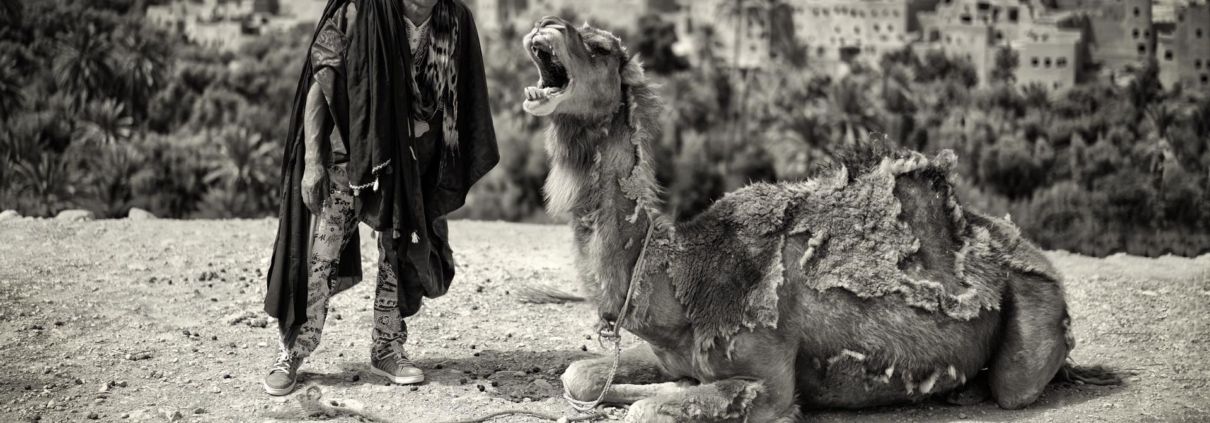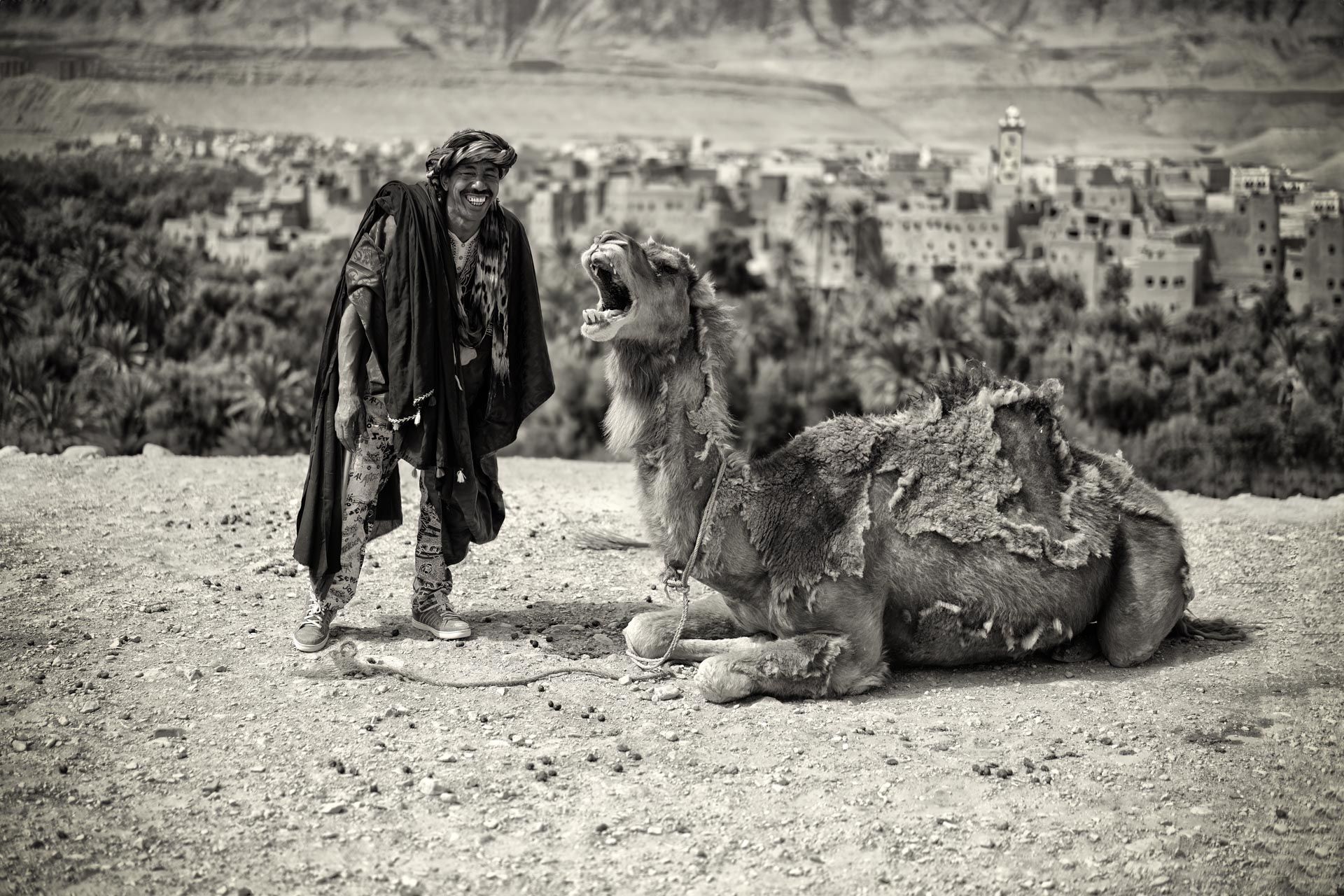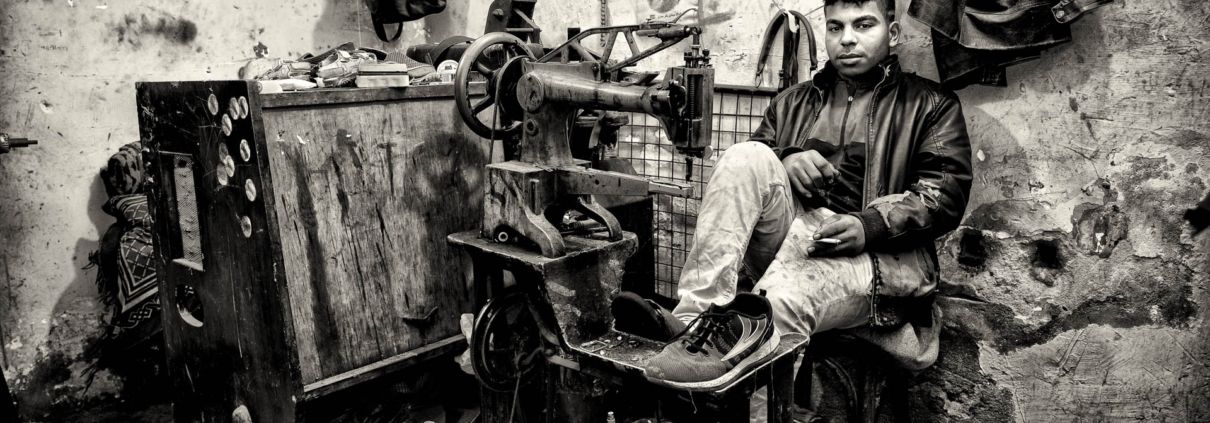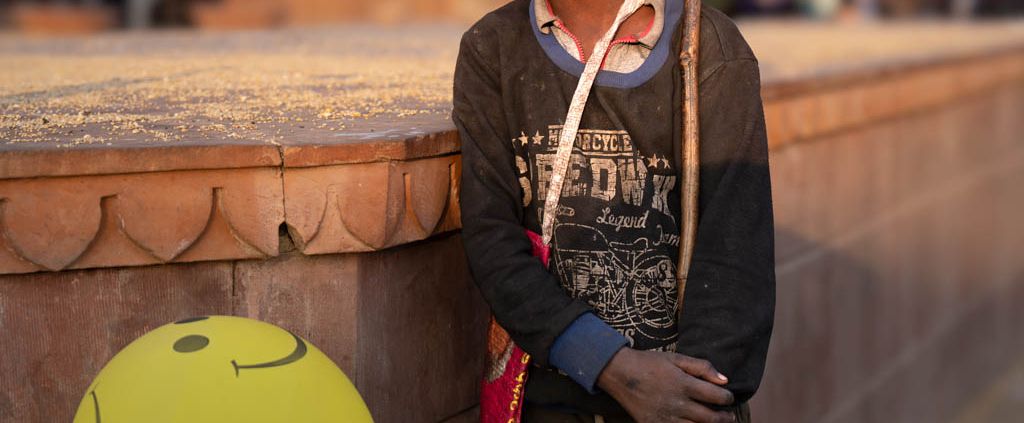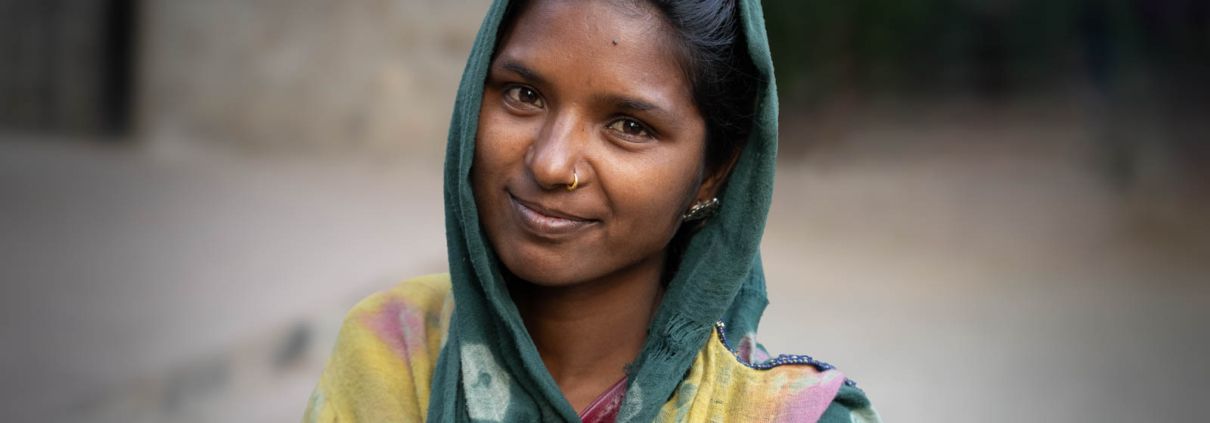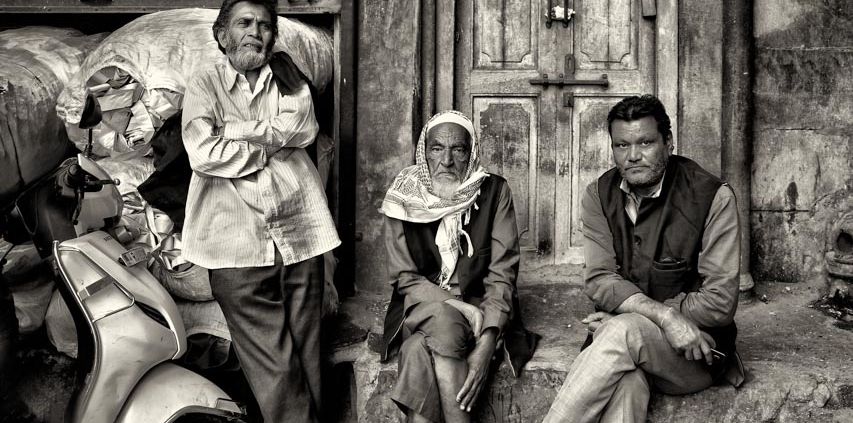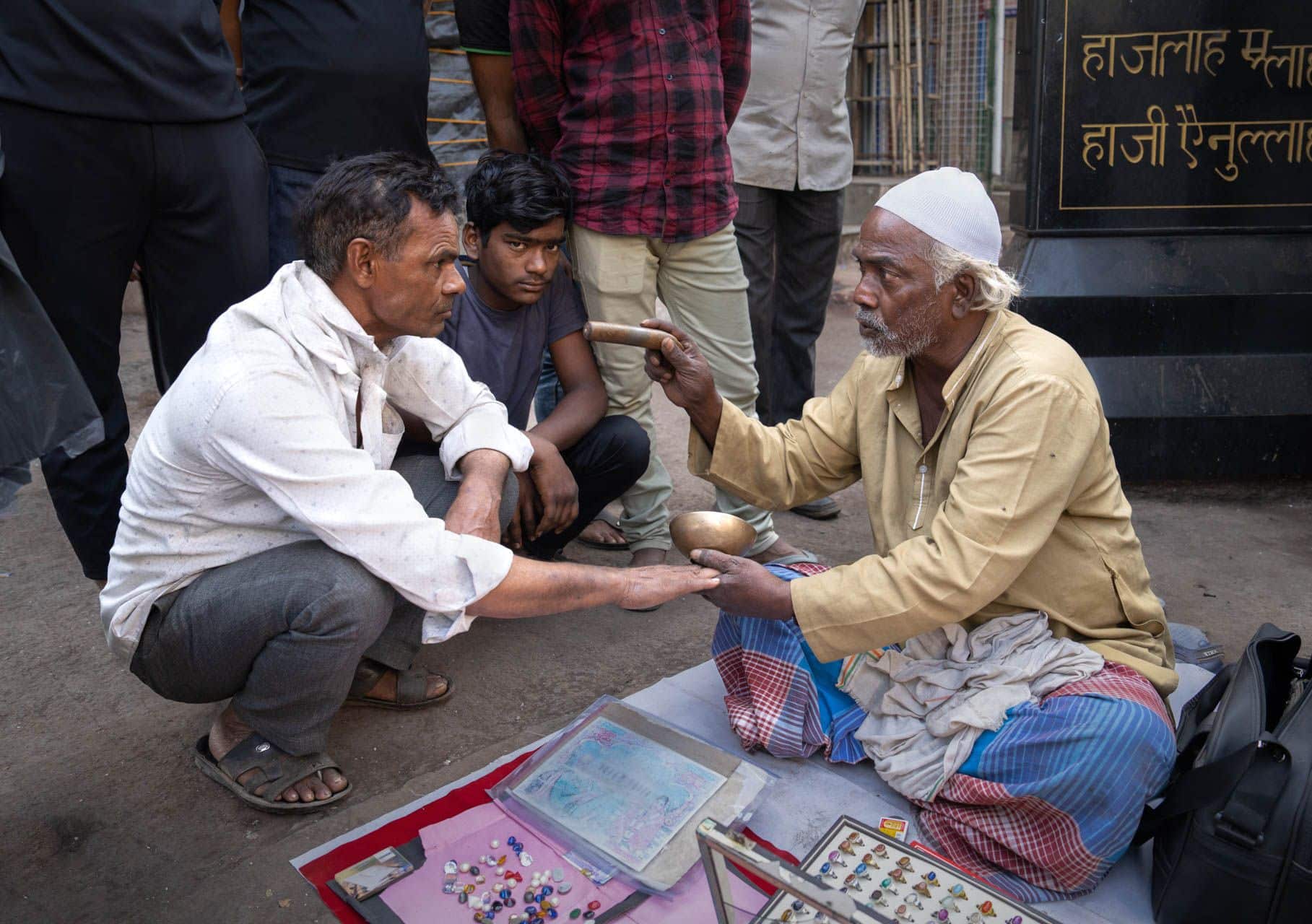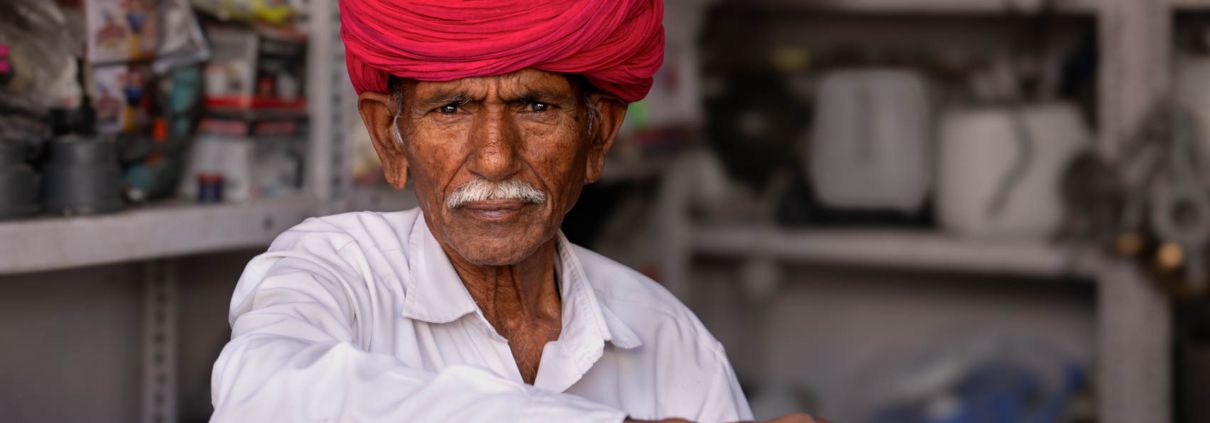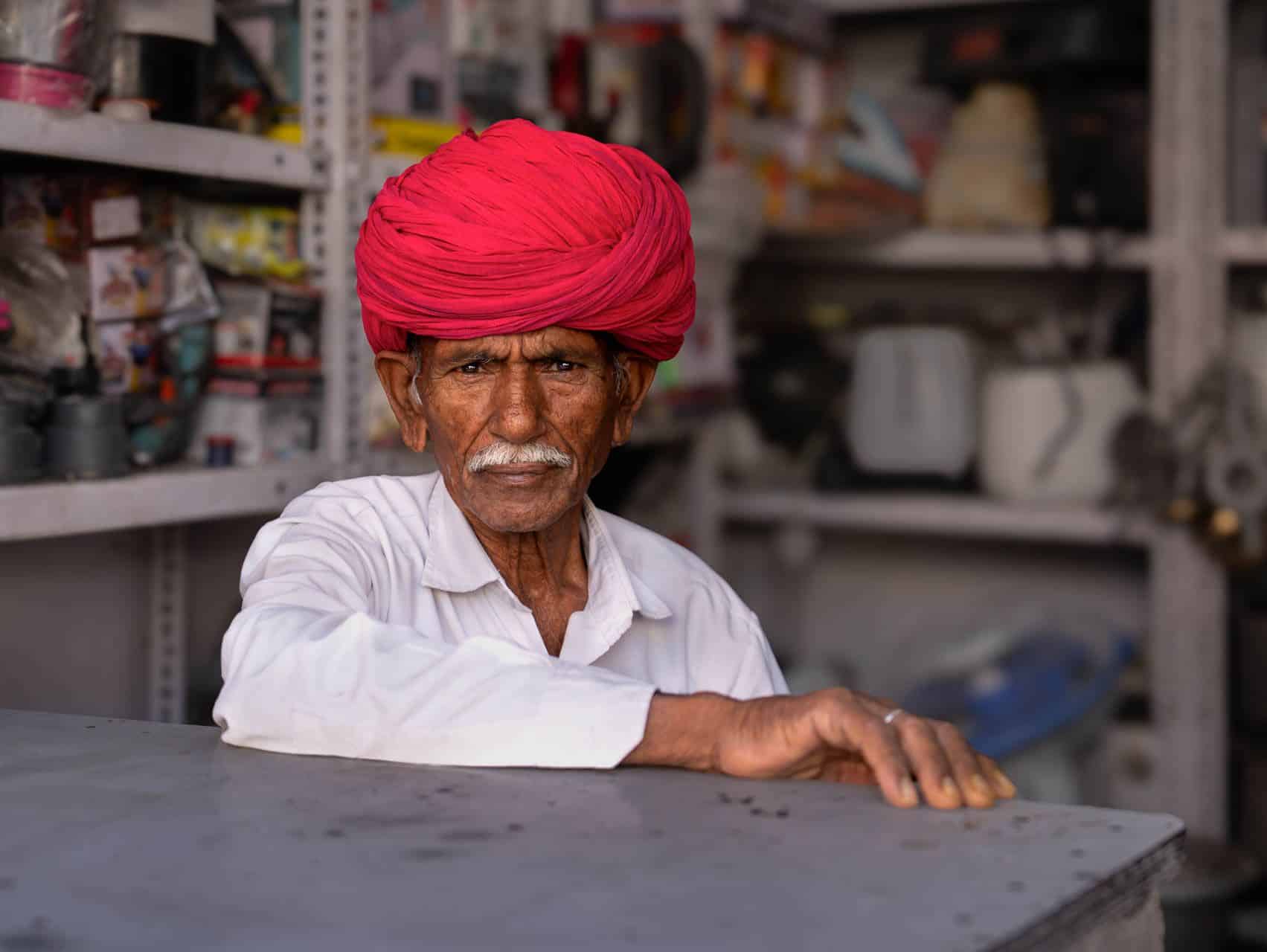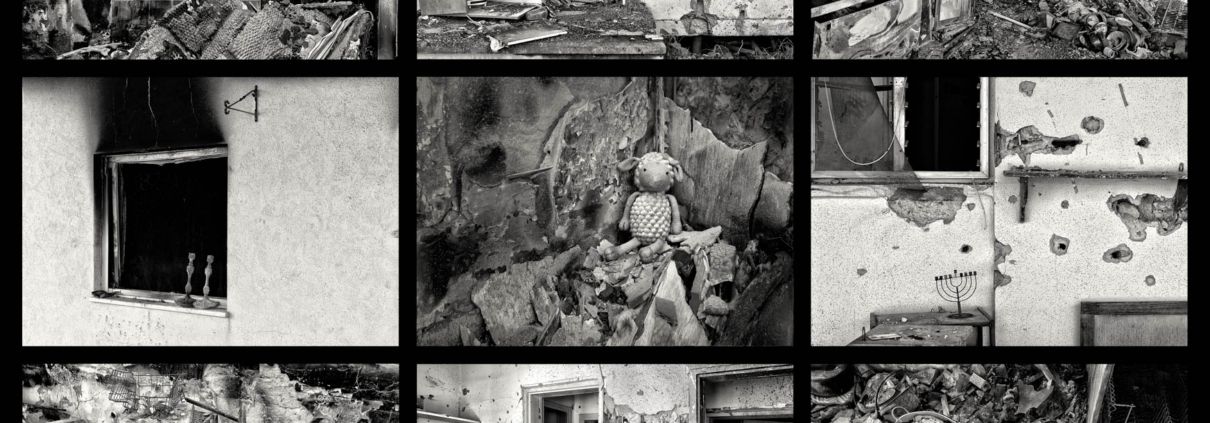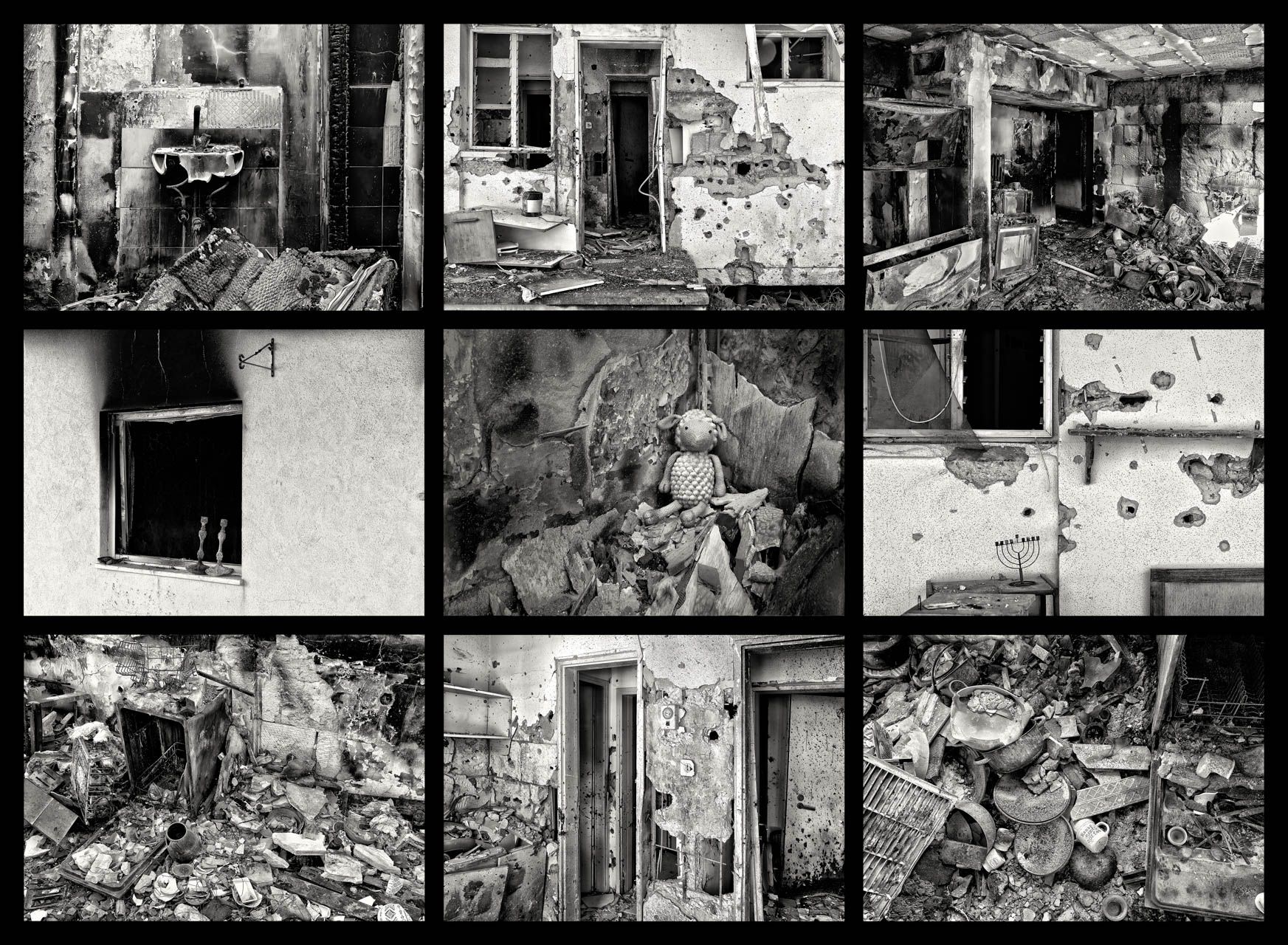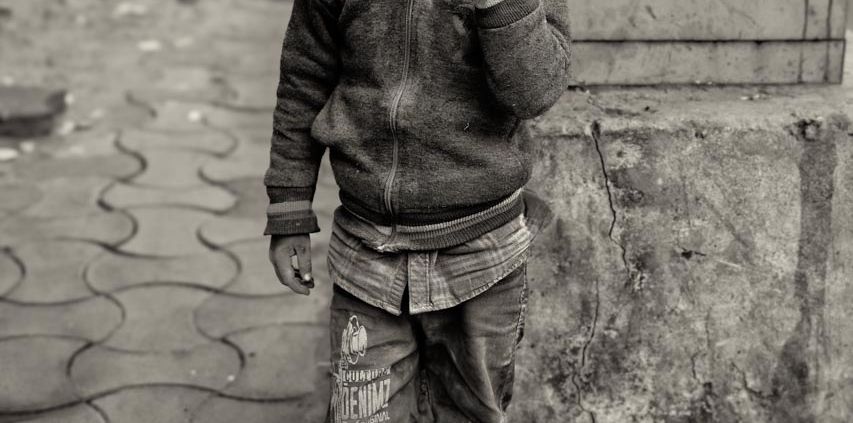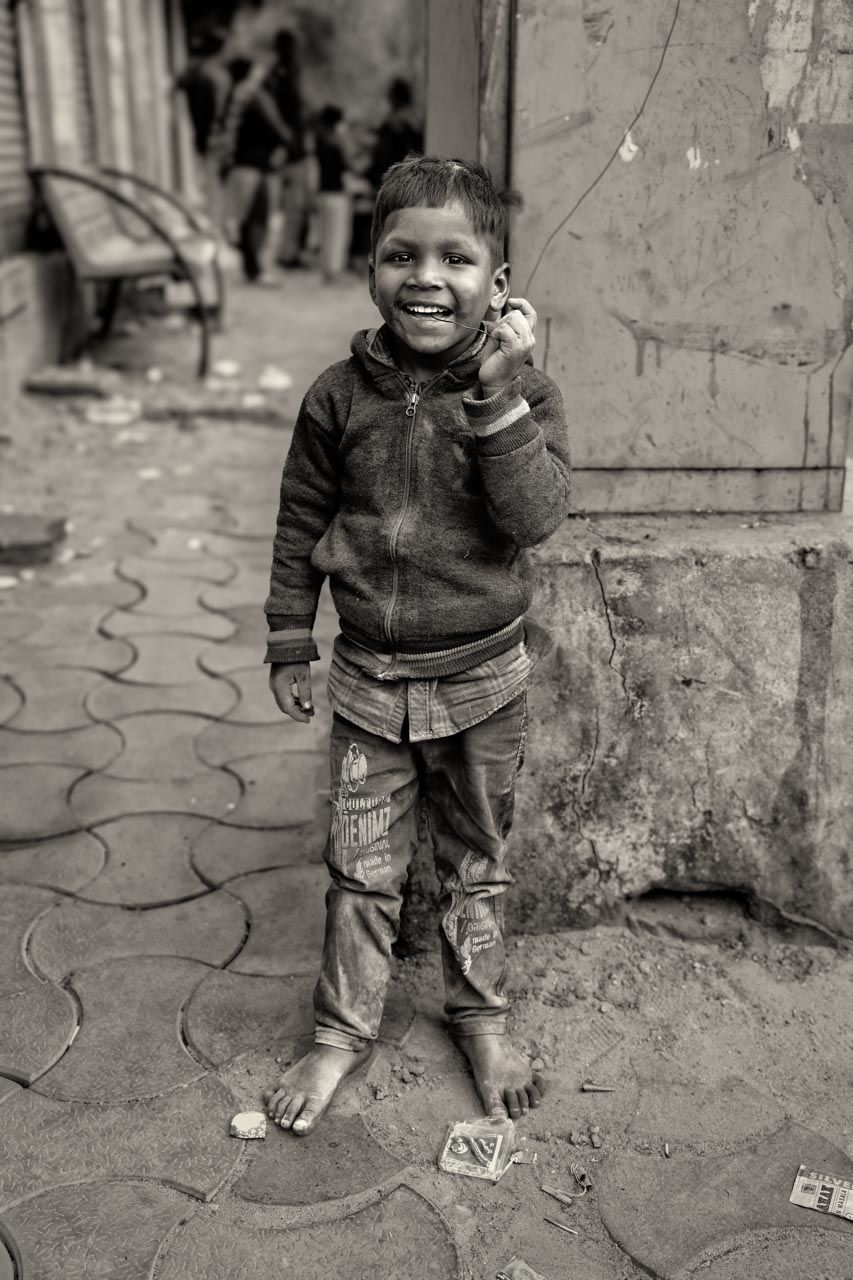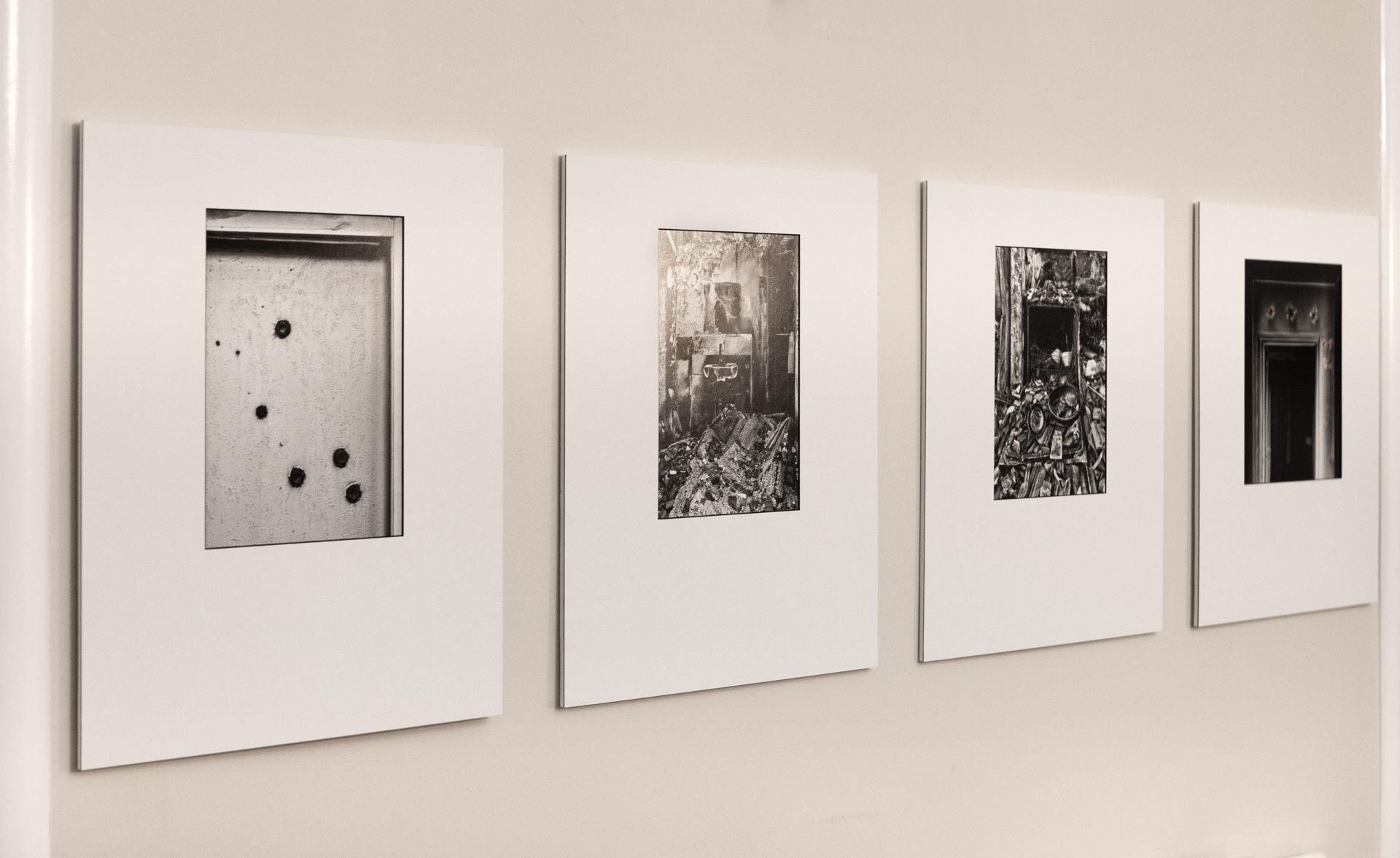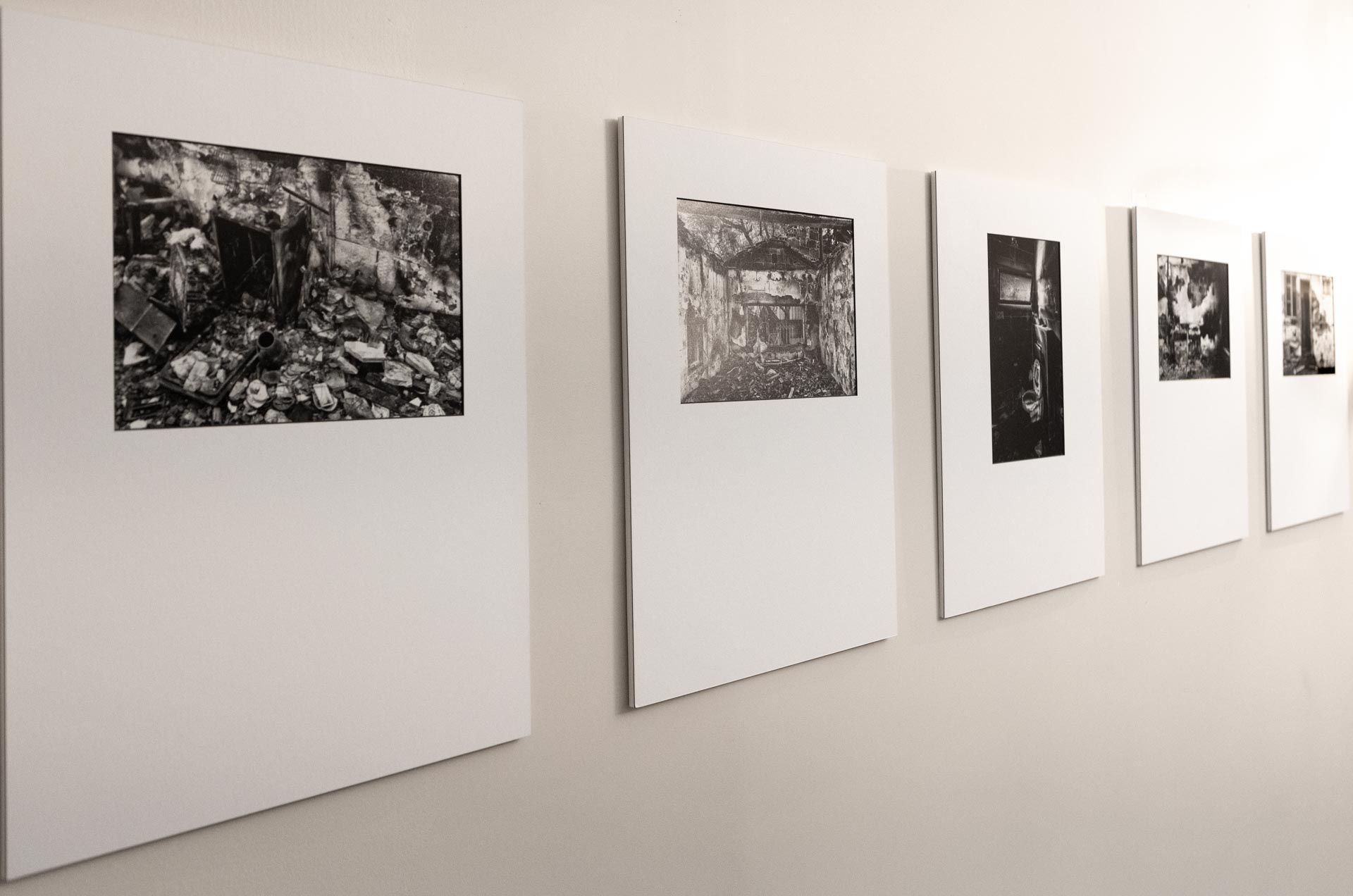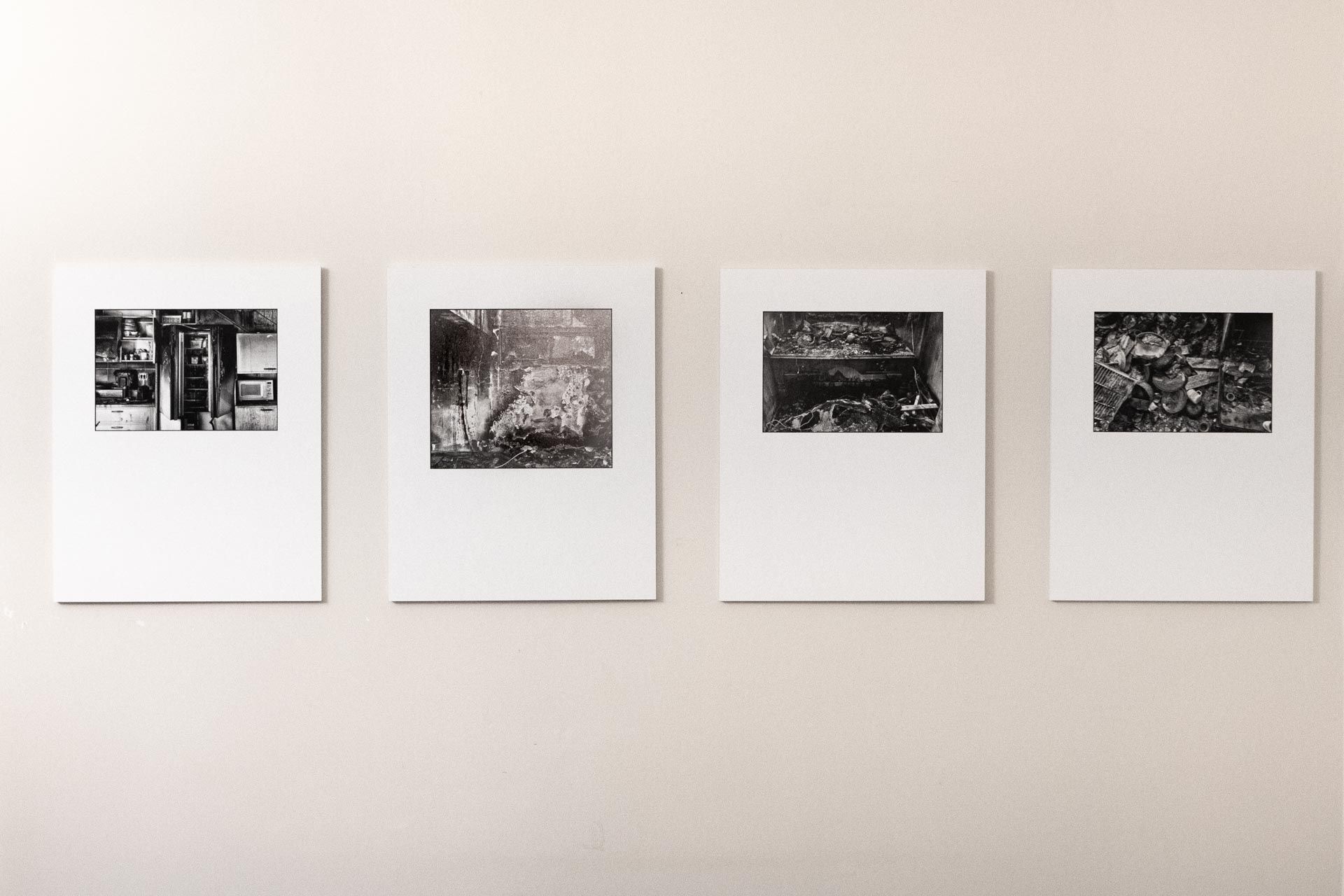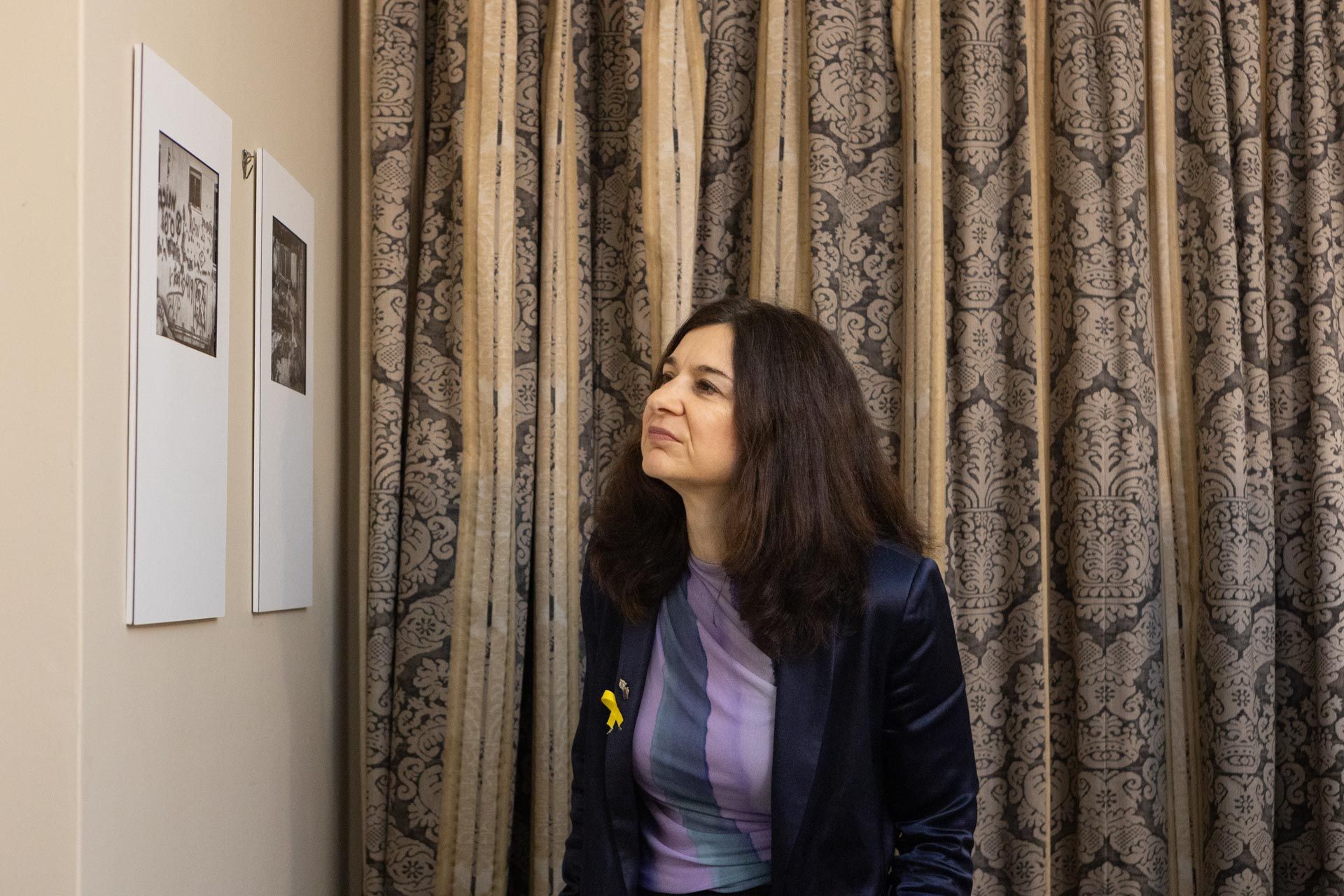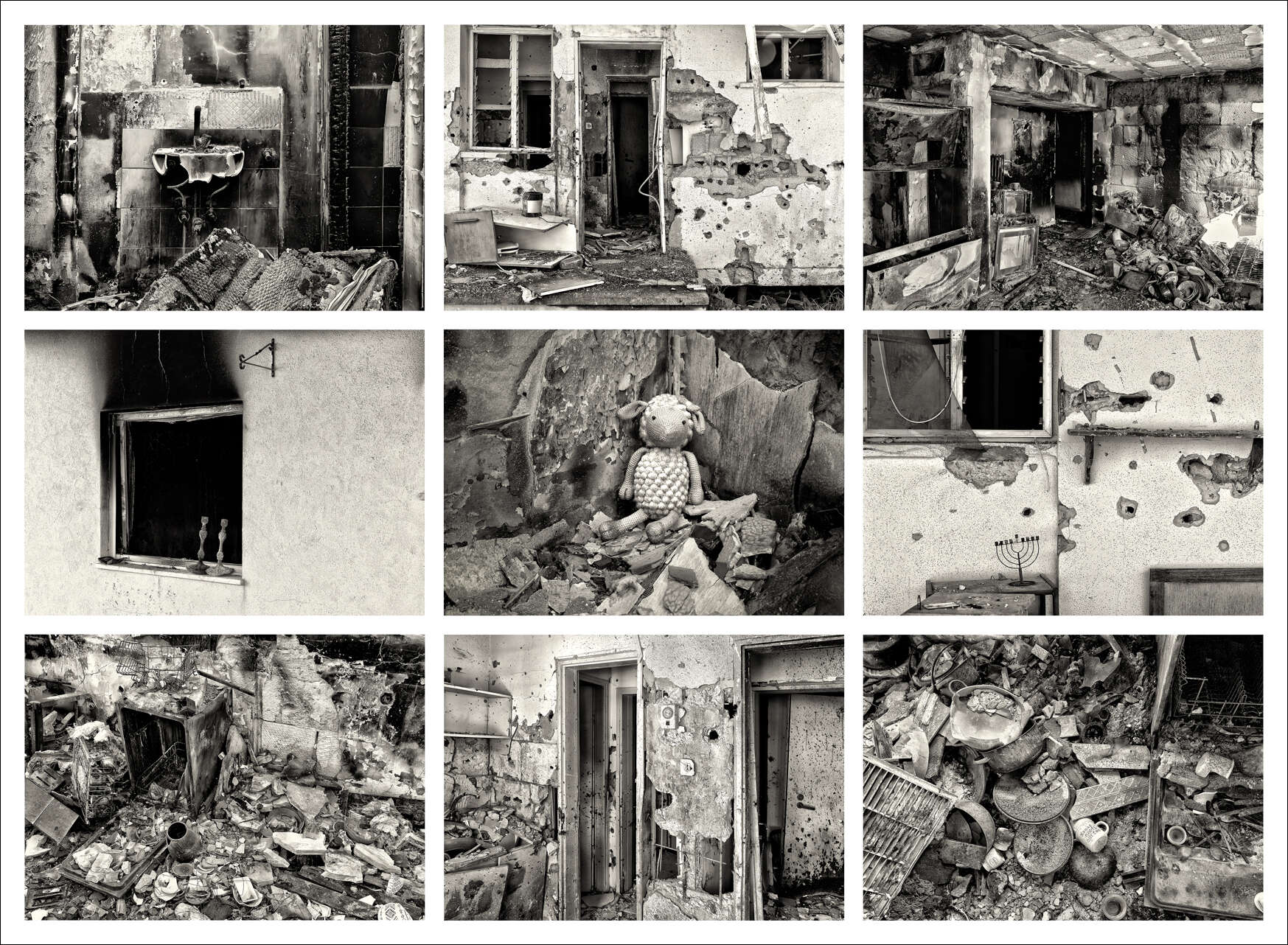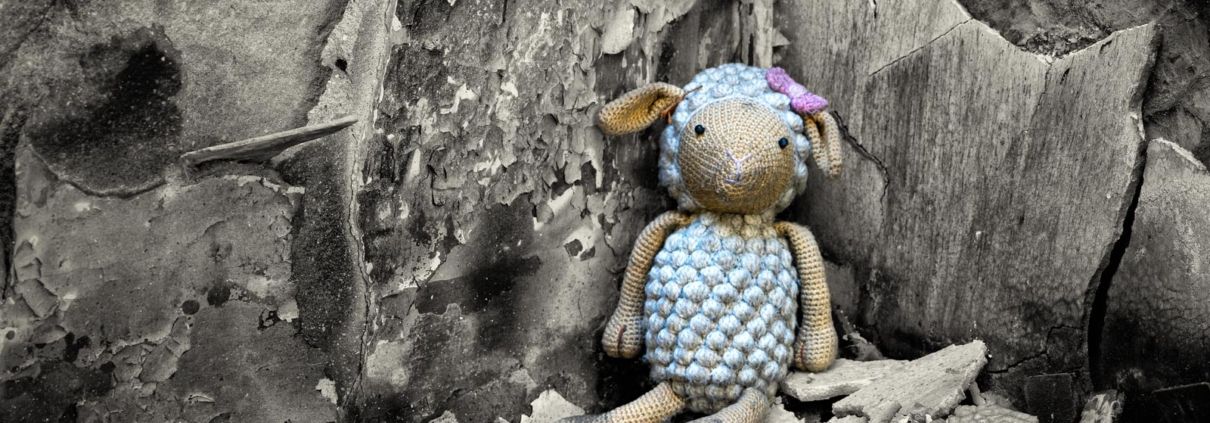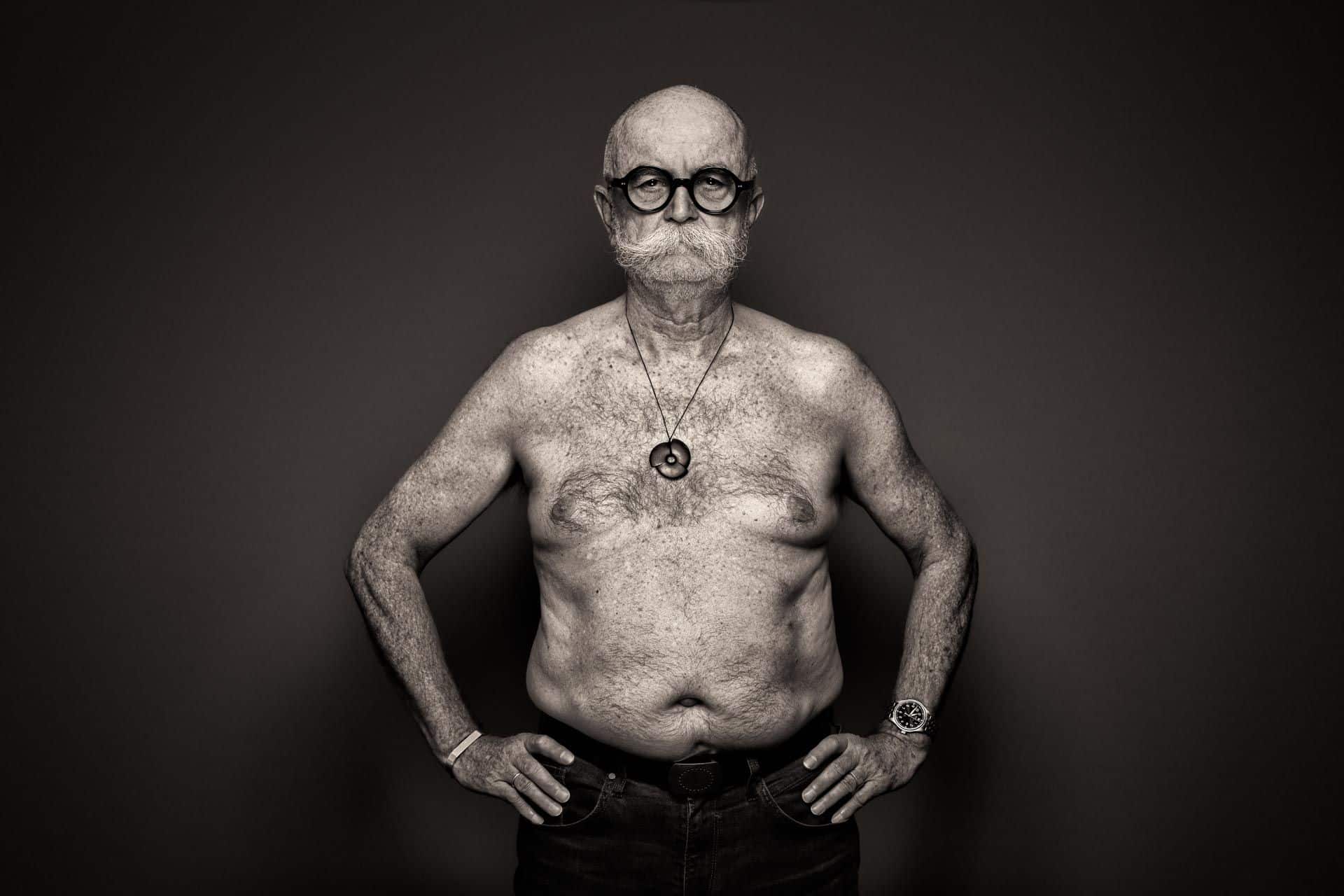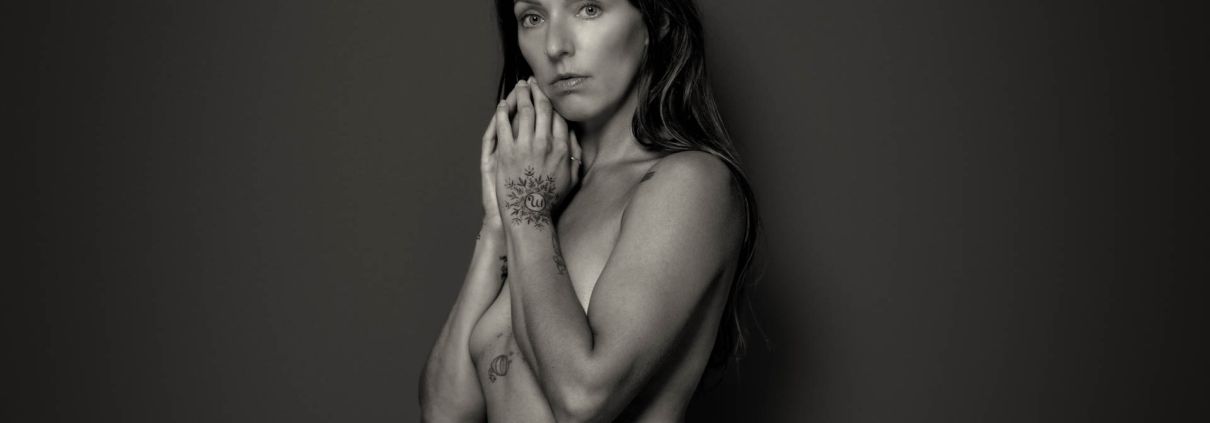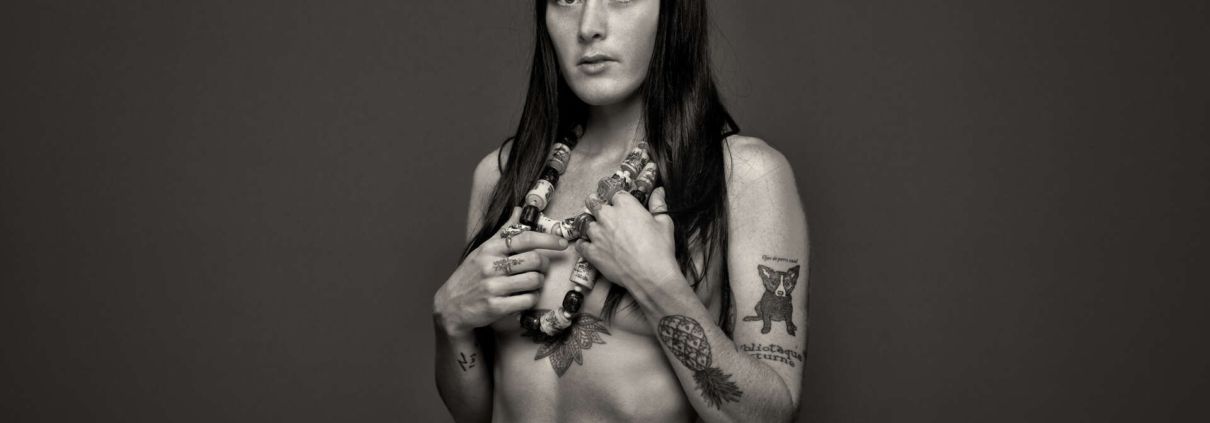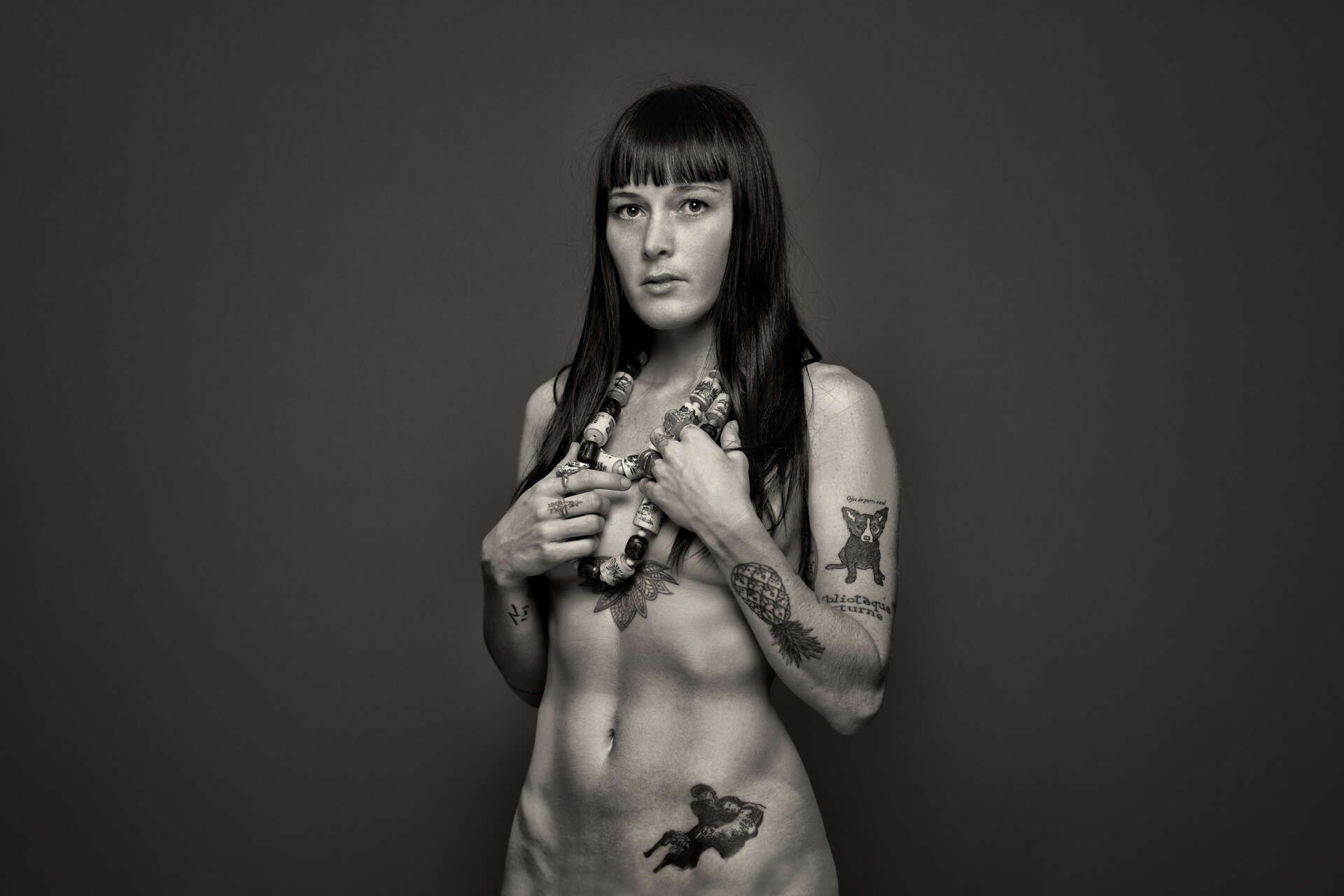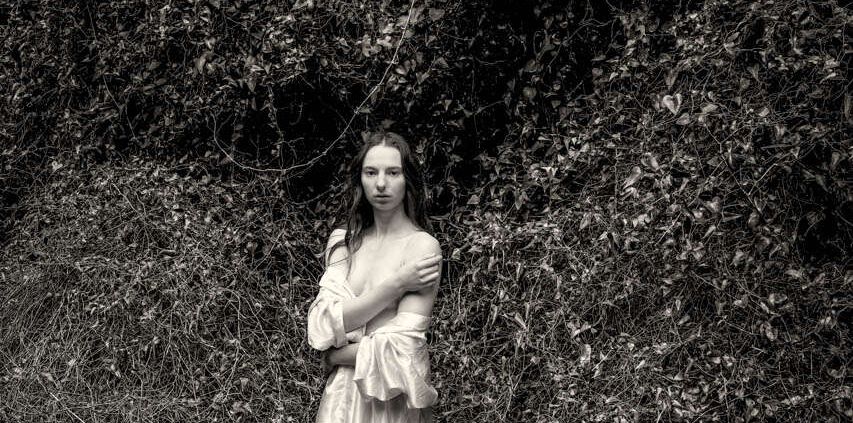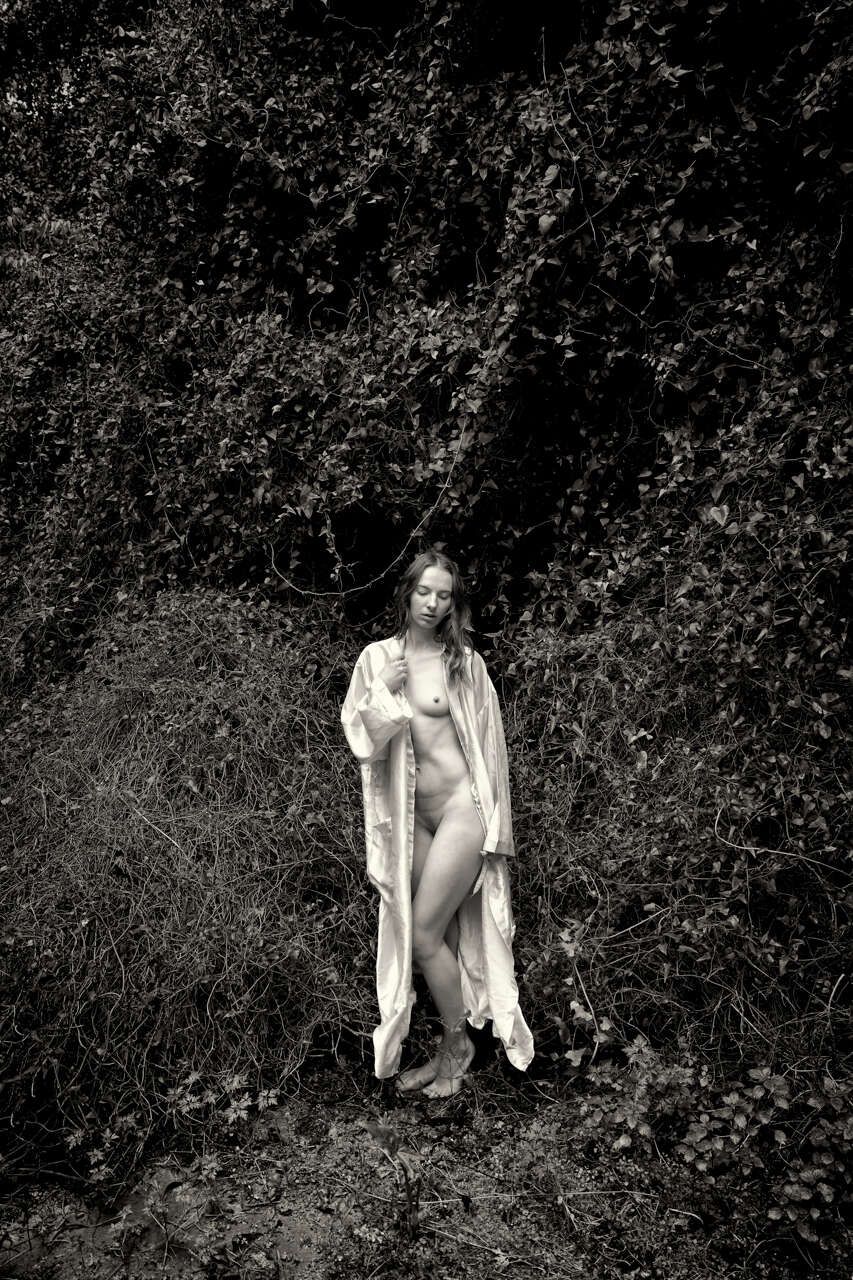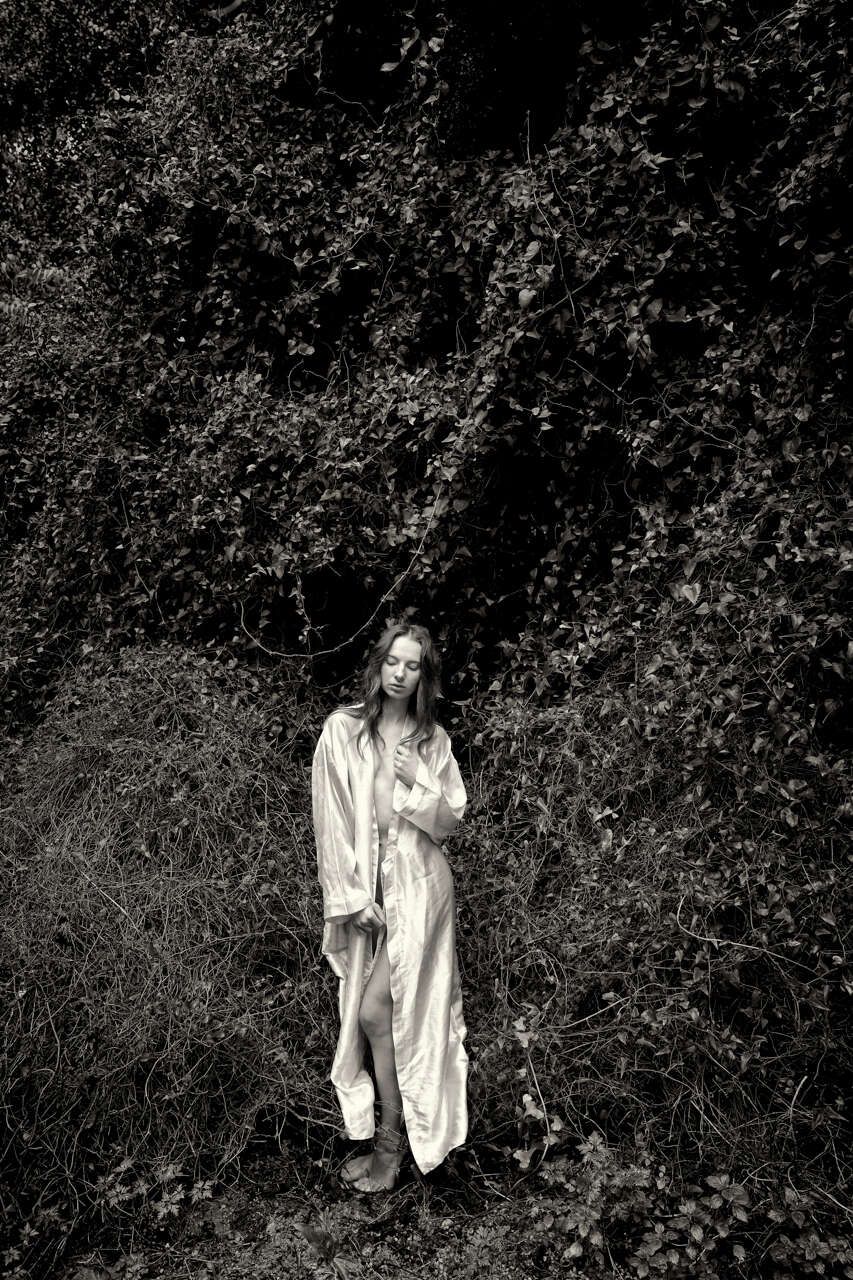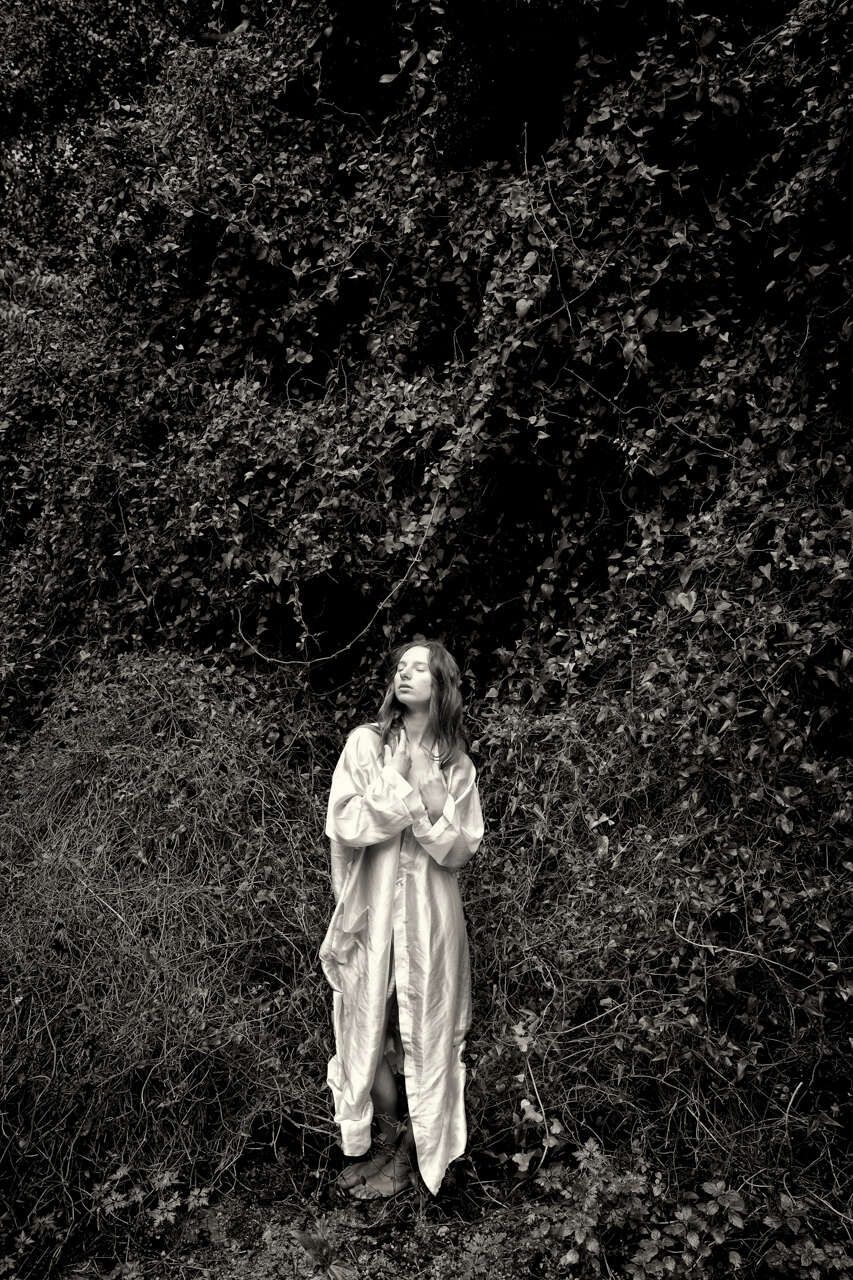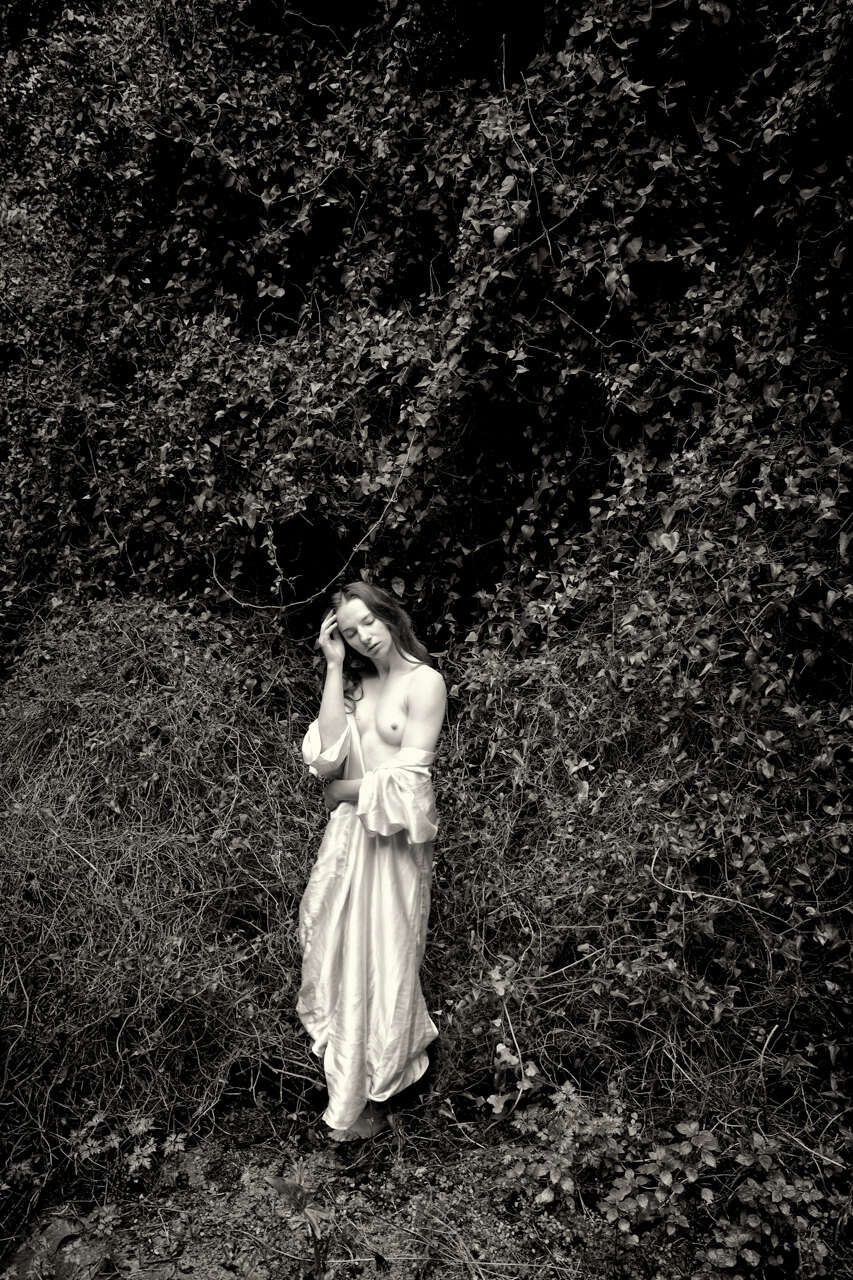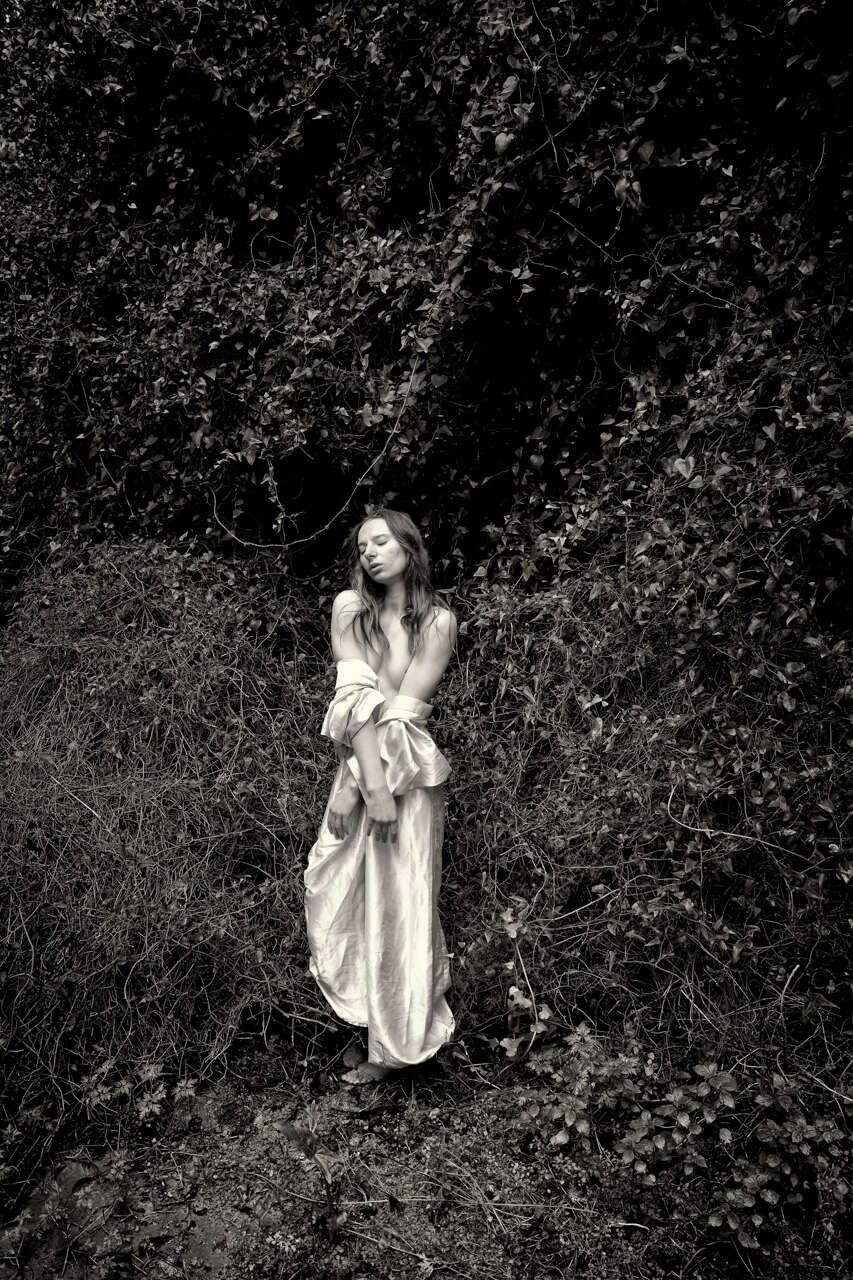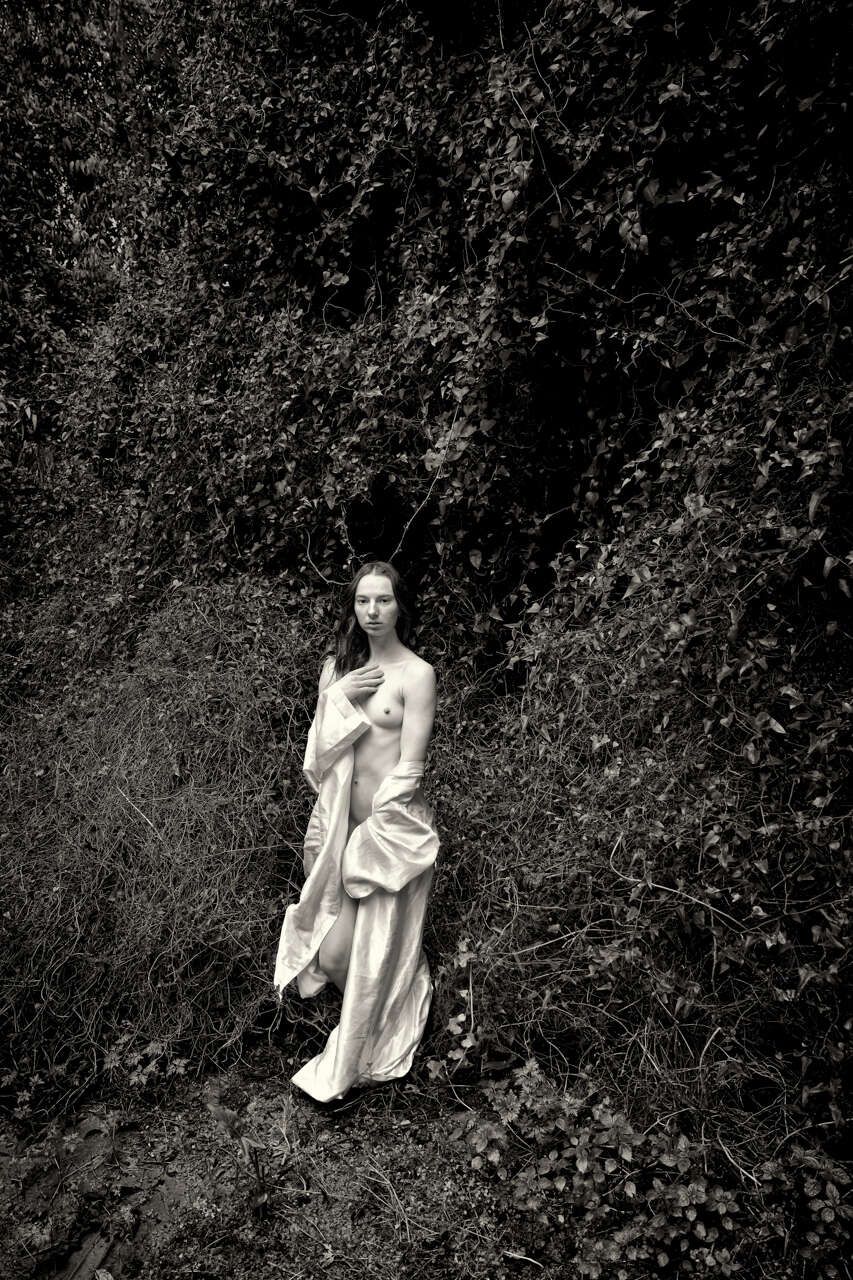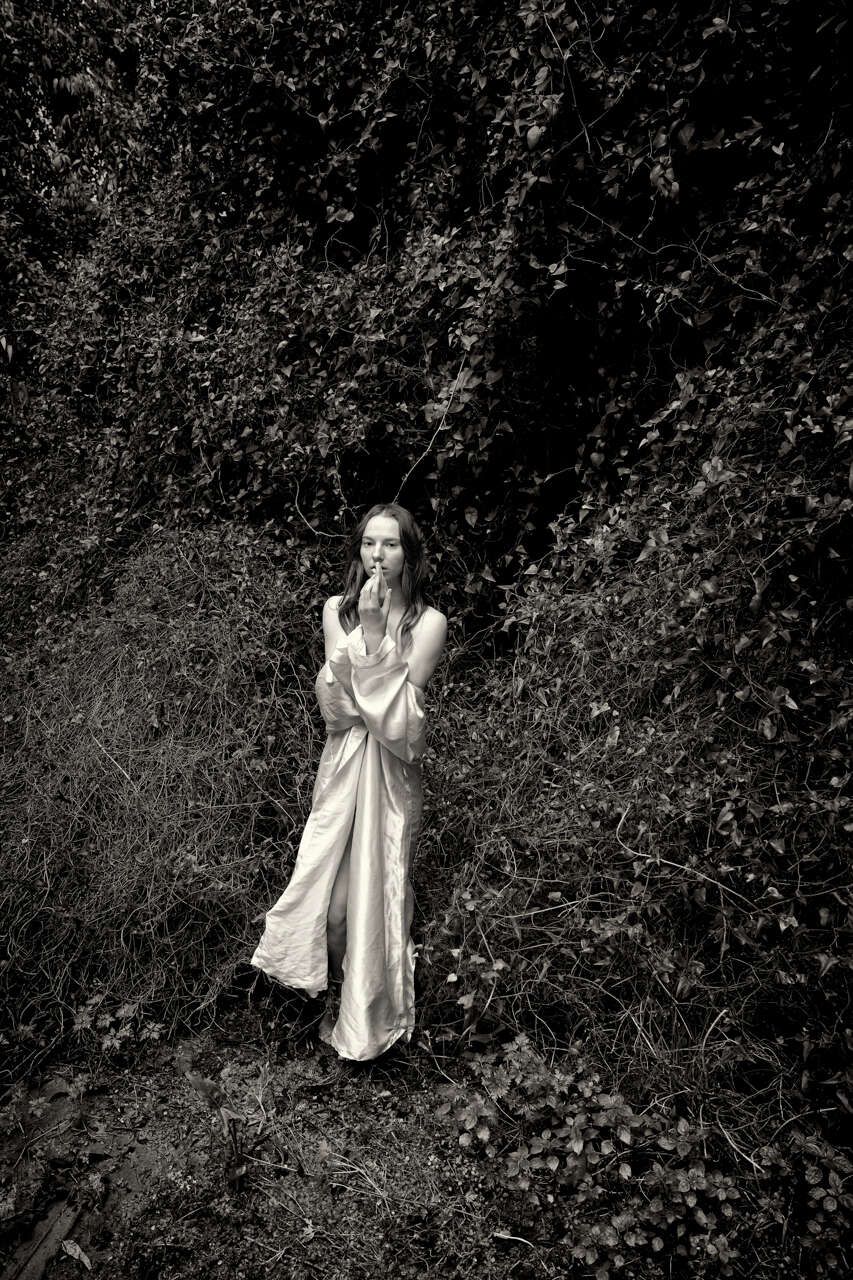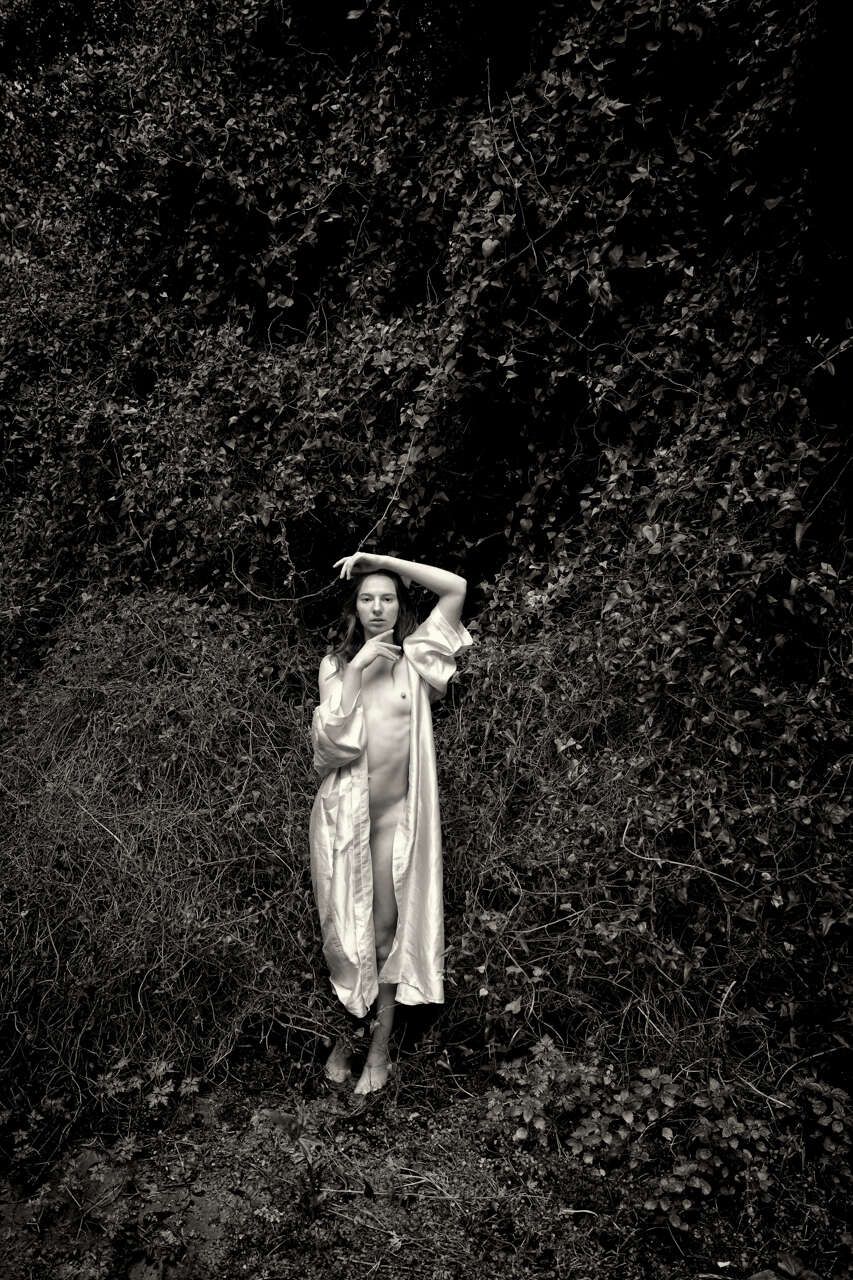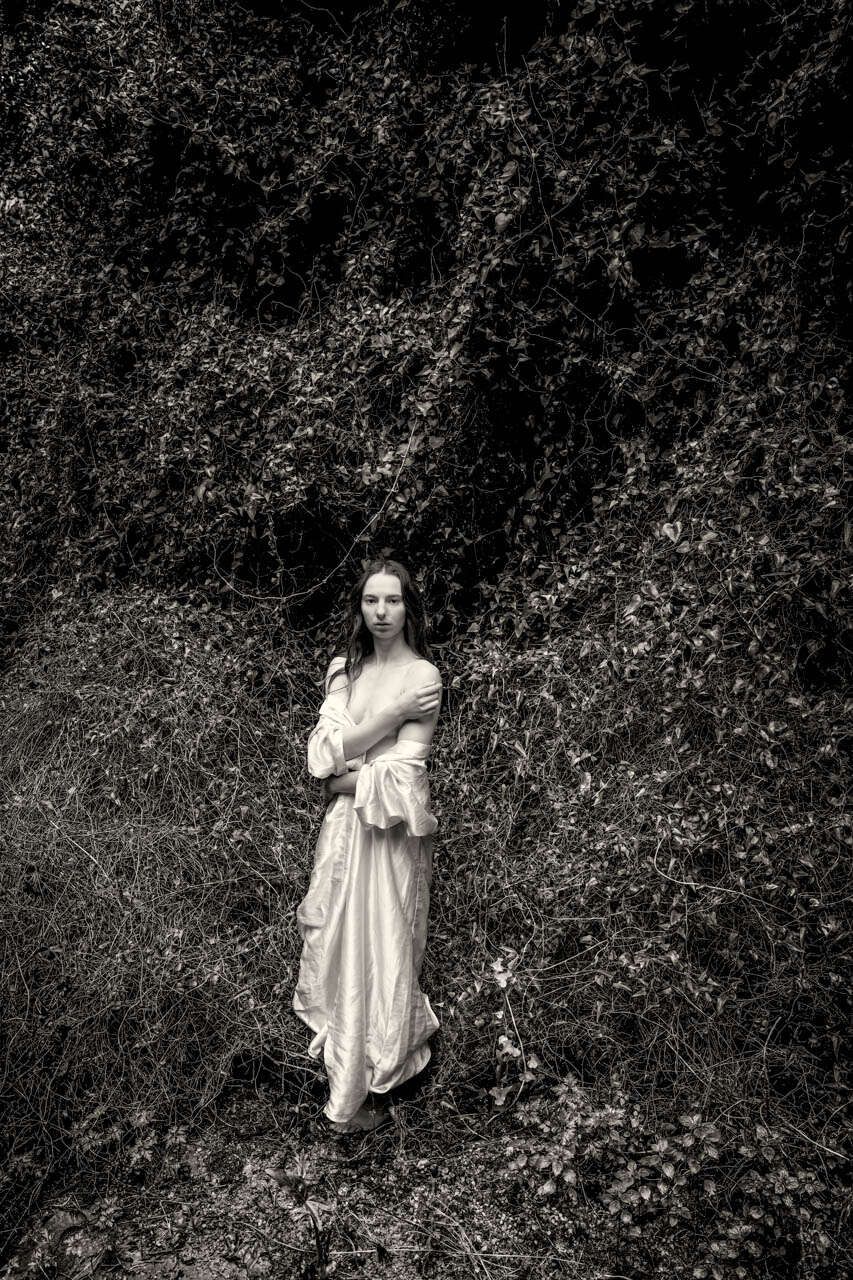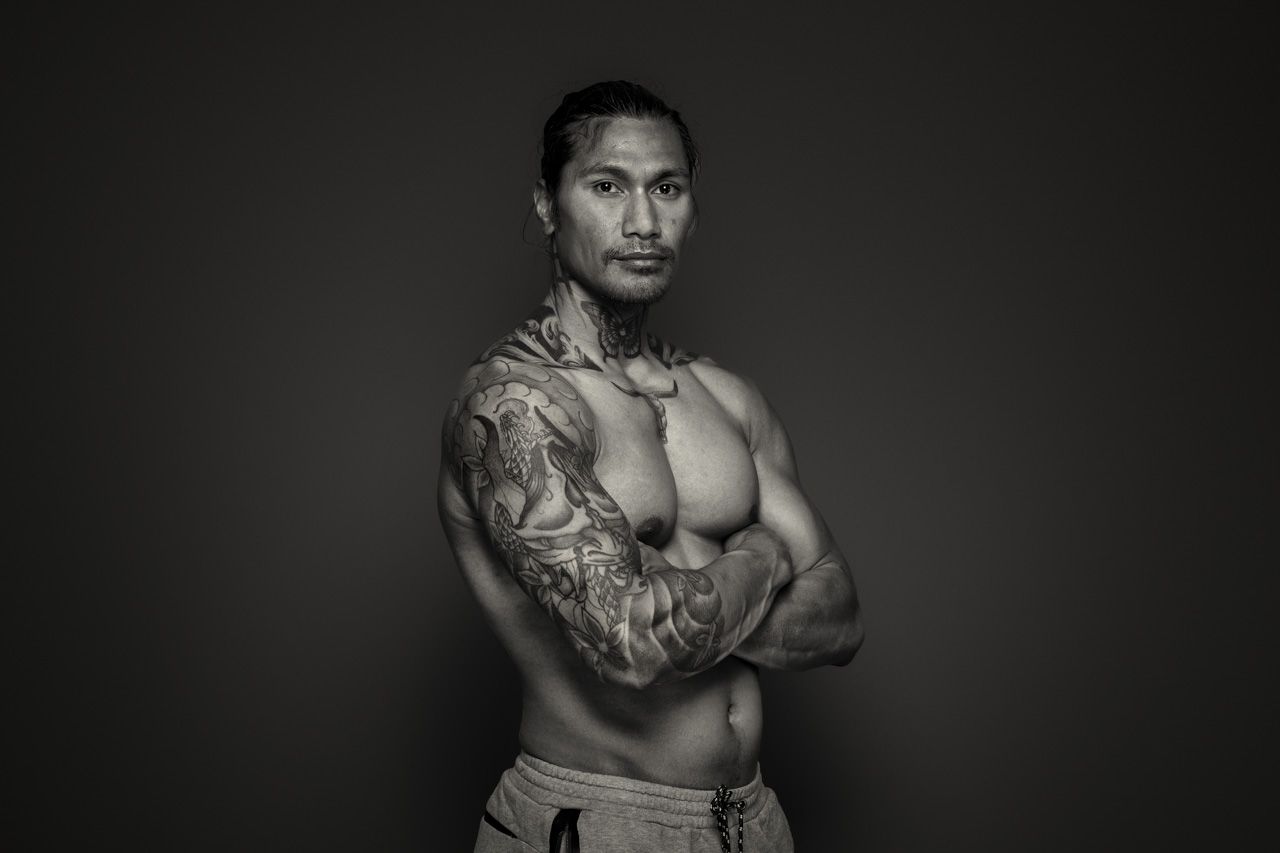The Aftermath Print
Click here to see The Aftermath series from Kibbutz Be’eri
The Aftermath opening event by Juliet Moses
President of the Jewish Council, June 22nd 2024
October 7. I would think that everybody in this room remembers what they were doing when they found out. I was at home, it was 4.35 pm on that day, and I was sent a message on a WhatsApp group, saying “Israel under massive missile attack” with a map from the red alert app showing all the targets. I quickly got onto social media and the news – I think I first saw a white pick up truck with Hamas gunmen on the back cruising the streets of Sderot being filmed – and realized straight away that this was no ordinary attack. Let’s just pause at that for a moment and contemplate those words – no ordinary attack – their absurdity, their unfairness, and the normalisation of something no other state on earth would be expected to tolerate or show restraint over.
My messages became increasingly frantic. To my family: “I’ve seen images of people slaughtered in the streets. I feel sick.” And 5 minutes later “They’re killing them in bomb shelters. Paraglided in. It’s absolutely gruesome”.
I try to stay off twitter over Shabbat, but at 6.52pm I tweeted the map of the rocket attacks and said “There’ve been infiltrations of terrorists from Gaza into Israel as well. I’ve seen images I wont share of slaughtered people in the streets. This is extremely distressing and means all out war”.
I sat there glued to social media and the TV until late at night, with a feeling a total helplessness that this could all be happening right now and we could be watching it unfold, and there was nothing that I could do. I went to sleep with a feeling of guilt, terror and dread, and woke up to news that some 700 people had been killed. For two weeks after that I felt constantly shaky and sick to the stomach. I know that was nothing unusual.
Why did we feel so shaken to the core? Why did we, and do we still feel this deep trauma, pain, shock, and grief, as if it is still October 7, as if time has stood still?
It wasn’t just the catastrophic intelligence failure that led to this massive attack, that shook our confidence, some might say our complacency or even arrogance, our belief in Israel’s ability to outsmart its enemies and protect itself, that saw homes being violated and desecrated, in a way that we thought would not happen anymore, and most certainly could not, would not happen in Israel.
It wasn’t just the massive scale of the attack, over 1200 people killed, over 250 taken hostage.
It wasn’t just the indescribable, medieval debauchery, degradation and depravity of the attacks, attacks that no label really does justice to. They were all of and more than a terrorist attack, a pogrom, an invasion, a jew hunt, an act of genocide. How do you describe the barbaric brutality that causes people to just disappear? Only this month, Israeli authorities identified the remains of Dolev Yehoud, a 35-year-old medic from the Nir Oz kibbutz, who it was believed had been taken hostage. Multiple forensic field tests had failed to reveal any DNA. It took 8 months to identify him. His fourth child was born on October 16. His sister, Arbel Yehoud, remains in captivity.
It wasn’t just the hostages who were taken and those who remain in captivity, to be used by Hamas as bargaining chips and sex slaves, and whom the word has allowed to be used as bargaining chips and sex slaves, and has abandoned, and tried their best to forget and actively remove any reminder of and obstruct us from rescuing and vilified us when we do. The Red Cross has not visited them once.
It wasn’t just who participated on that day – so-called civilians, journalists, members of UNRWA.
It wasn’t just the bloodlust, pride and jubilation of those who participated somehow paradoxically coupled with a deadeyed coldblooded mechanical execution – I use that in both senses of the word. The ecstasy of the mob in Gaza as the hunters return with their bounty, the mutilated body of Shani Louk splayed on the back of a truck, spat on and hit with planks, greeted with ecstatic cries of Allah Akbar. The recording of the son who rang his parents with great excitement to announce that he had killed ten Yahoud. The terrorist who shot a father dead in his Kibbutz Be’eri home, and is caught in the house’s security cameras as he walks into the kitchen and grabs a soft drink out of the refrigerator and drinks it, as the two young sons sit there, one saying “Papa is dead. Papa is dead. Why am I still alive?” while the other sits there with one eye gouged out.
It wasn’t just the livestreaming and gopro-ing for the world to see, the granddaughter who discovered her grandmother’s murder when her assailant filmed it on her phone and posted it on her Facebook wall. At least the Nazis – and let’s stop and think about those words too and what it says that we might ever use them – at least the Nazis tried to hide, went to great lengths to hide, the evidence of their crimes. The calculation that Hamas made was that the humiliation, pain, terror and psychological torture their recordings inflicted would be worth it, and outweigh any outrage, any damage to their cause, and you know what? They were right.
They were right, because there are those around the world, including in New Zealand, including academics and politicians, who despite all the evidence, are willing to infantilise, trivialise, justify, defend, and celebrate Hamas and its evildoing. But they were also right because there are those who reject the evidence of their eyes and ears.
By 16 October, I understood that we were already dealing with October 7 denialism. My younger son was at his last Uni lecture for the year on Islam, as it turns out, and was told by a young woman in a hijab that the Nova festival attack was “Zionist propaganda”. Some time later my mother engaged with an anti-Israel protester and was told the footage of that day was all AI. In this war, even when a photo or footage isn’t AI-generated, and a lot have been – we have all seen the 6-fingered Gazan boy – the possibility that it could have been, sows confusion and doubt.
Perhaps worst of all is the denial that rape was used as a tool of war on that day, despite countless eye witness testimonies, and forensic and other evidence that I won’t discuss. Apparently progressive people, who a few years before were happy to destroy a man’s career based on a rumour that he touched a woman’s knee without her consent because #believe all women, suddenly found themselves disbelieving substantial, undeniable, evidence of unspeakably savage rape and sex-based violence, as some of us saw on Wednesday night when we watched Sheryl Sandberg’s powerful documentary Screams before Silence.
Of course, there has been a campaign to erase and appropriate our history for a long time – the Temple is built on top of and its existence denied, we are told Jesus was Palestinian, our sacred historical sites are recognised and protected at the UN as Muslim sites. But denial of our trauma is much more than just delegitimization – though that is bad enough. We must be clear that it is integral to the genocidal strategy that Hamas and the Iranian regime is committed to, and that people around the world, unwittingly or not, are enabling. Denial is an inversion of reality and morality that strives to reshape history in order to demonise victims and rehabilitate the perpetrators.
As the late Armenian historian Professor Richard G. Hovannisian said “Complete annihilation of a people requires the banishment of recollection and suffocation of remembrance. Falsification, deception and half-truths reduce what was to what might have been or perhaps what was not at all.”
In his book “Crusade in Europe” Eisenhower wrote about the liberation of the camps at the end of WW2 “I have never felt able to describe my emotional reactions when I first came face to face with indisputable evidence of Nazi brutality and ruthless disregard of every shred of decency. Up to that time I had known about it only generally or through secondary sources. I am certain, however that I have never at any other time experienced an equal sense of shock. I visited every nook and cranny of the camp because I felt it my duty to be in a position from then on to testify at first hand about these things in case there ever grew up at home the belief or assumption that `the stories of Nazi brutality were just propaganda.” How prescient that was.
This is what Ilan has done, and why it is so crucial. He has chosen to testify. He travelled to Israel, and on February 7, 4 months to the day, became one of few people to get access to Kibbutz Be’eri, to bear witness to the devastation of that darkest of days. He has shown great commitment in doing so, and in putting this exhibition together, at personal cost and sacrifice. It seems there are many people who just don’t want to know or see.
But we have to keep trying, all of us, to share the truth, because it can make a difference. According to a Palestinian poll released on June 12, published by the Palestinian Center for Policy and Survey Research, 90 percent of Palestinians have not seen videos from that day, which is interesting given they seem very connected to social media and the amount of videos that they seem to record and circulate themselves. Importantly, however, the results also show that those who watched the videos are about fifteen times more likely than those who did not, to believe that Hamas committed atrocities on October 7.
I can think of three main reasons why preserving, recording and communicating the truth is vital.
First, to honour the victims and survivors. As Elie Wisel said: For the survivor who chooses to testify, it is clear: his duty is to bear witness for the dead and for the living. He has no right to deprive future generations of a past that belongs to our collective memory. To forget would be not only dangerous but offensive; to forget the dead would be akin to killing them a second time.”
Second, as Wiesel alludes to, our collective memory is who we are as a people. The verb Zachor (“remember”) is repeated everywhere in Jewish ceremony and liturgy: under the wedding canopy, during Seder, in the Ten Commandments, during Shabbat, in siddurim. Now, October 7 is forever embedded into our collective memory and will be handed down the generations as part of our story. And we must be better at telling our story to the world.
Third, we must stand for the truth for the sake of truth itself, because open, free and liberal societies, which are the societies that Jews thrive in but are also the best for civilisation itself, depend on the truth. If all we have is feelings, moral relativism, and narratives, we as a society will be destroyed.
So I thank you all for being here today in person or online to bear witness. Remember that, while we are not physically fighting for Israel, we can play a critical part in the battleground for the truth, to combat the falsification, distortion, revision and erasure of history and to be the guardians of our collective memory. And at this moment in time for the Jewish people, I would suggest that it is a moral necessity for us to do so, and to play our part in continuing the most inspiring, unbreakable story of an ancient people who have survived and stayed true to ourselves for over 3000 years against all odds.
Am Yisrael Chai.
Julian
Julian Cowey
Filipo Fifita
My name is Filipo Fifita. I was born in Vā vā’u and raised in the main island of Tongā, specifically in the small village of Ma’ufangā. Growing up, my grandparents and aunties played a significant role in shaping my beliefs and perspective on life. They instilled in me the values of discipline and family obligation, which are deeply rooted in our traditional culture. These values are considered essential for navigating life’s trials and tribulations, as they emphasize fulfilling family duties and staying true to our faith.
However, everything changed when I migrated to Aotearoa, New Zealand, specifically to the Bay of Islands in Kerikeri, at the age of 10. In this new environment, predominantly inhabited by pākeha, I experienced a profound displacement that led to a loss of identity and hindered my sense of belonging. I longed to be back with my family in Tongā, and only later in life did I truly understand the impact of this disconnection from my roots.
To cope with this feeling of displacement and dampen its effects, I turned to substance abuse, primarily alcohol at first, but eventually spiraling into more harmful substances over the years. This personal and destructive pathway caused tears, pain, and had detrimental effects on my psychological and mental well-being, as well as on those around me. Looking back, I deeply regret the lack of empathy, compassion, and disregard for the well-being of others that I displayed during that time. If only I had possessed the mindset I have now, things would have been different, and perhaps we could share a laugh at my past foolishness.
It is important to acknowledge that I bear sole responsibility for not seeking the support and guidance I needed during those challenging times. In hindsight, I realize the significance of addressing problems and seeking help sooner rather than later before the people and things we cherish become casualties of our distorted reality.
Now, as an aspiring occupational therapist student, I am determined to advocate for better mental and physical health. My goal is to create a space where individuals can navigate their daily struggles and overcome the stigma surrounding men’s mental, psychological, and physical well-being. By sharing our collective voices and stories of overcoming struggles, we can work together to combat these issues and encourage others to seek proper help.
I believe that one day, we will triumph over the shame and stigma associated with seeking help. Together, we can create a society that prioritizes mental and physical well-being for everyone.
Professional Experience
Professional Work Experience
-
Wow Photography · , Auckland, New Zealand
I am only as good as my last image so always aspiring to exceed my reputation of producing unique, quality photographs while providing outstanding value. I am achieving this by focusing on my customers’ real needs and delivering my best work. In pursuit of my goal to become a leading portrait photographer I choose to treat business partners, customers and stakeholders with respect while listening to the marketplace. -
Feb 2010 – Dec 2010
-
Orcon ·
-
Jan 2006 – Nov 2008
Responsible for gathering Requirements and analysis of data. Conducting workshops and facilitating brainstorming sessions. Writing Business Cases and developing Business Requirements to support users’ needs and to improve business performance. Building powerful presentations and acquiring stakeholders sign-off. Supporting the development team, writing test plans and test cases. Managing users’ expectations, project scope and timeline. Delivering the most cost effective solutions. Implementing disciplines and structure to ensure stable environment and best practice throughout development.
Initiating, promoting and coordinating the selection, customisation and implementation of a budgeting, forecasting and reporting system that extract data from Oracle db. I have effectively identified the client needs and offered a cost effective solution. I established contact with potential suppliers, facilitated contract negotiations and took an active part in comparing and selecting the best alternative.
Producing the Business Case and Business Requirements documents, designing the project plan and defining the project scope.Taking an active role in managing users’ expectation, facilitating conference meetings, ensuring systems are in place, data is provided and delivery meets user expectations. My responsibilities included managing day-to-day activities, providing internal liaison with the supplier, Finance and Infrastructure. In addition to supporting Finance in defining their requirements, I facilitated consultative design workshops and coordinated resources and activities ensuring successful delivery.
Project Manager in establishing decision support systems for the following areas:
Production management, Inventory provisioning, Procurement management, Alternative components allocation, Telephone calls trend analysis, Electronic traffic signs control and Financial credit scoring.

